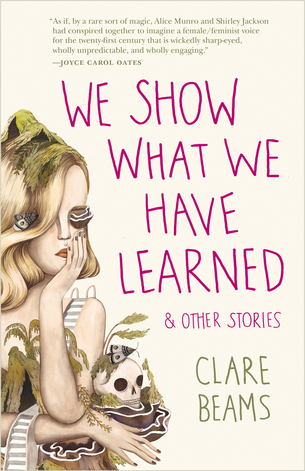Clare Beams Proves She’s a Captivating Literary Voice with We Show What We Have Learned
Books Reviews Clare Beams
In her debut collection of short stories, We Show What We Have Learned, Clare Beams offers readers haunting narratives of individuals and communities under transformation. While these tales feature a variety of characters and settings, what unites them is how a combination of the otherworldly and the mundane illuminates the psychic undercurrents of change.
Four of the nine stories in Beams’ collection take place in schools, which is fitting as they are institutions dedicated to transformation. As the headmaster in the opening story “Hourglass” declares, “Education is nothing less than the shaping of the soul.”
 With “Hourglass,” Beams highlights the sinister side of conversion mediated by education. A new student at a boarding school advertising a “Transformational Education” for girls learns to fit into a literal corset. As she acclimates to her physical reformation into an hourglass shape, she figuratively incorporates the headmaster’s vision for beauty and truth. Adding to this mordant take on education is the titular story “We Show What We Have Learned,” which features a meek teacher’s disintegration in front of her disengaged students. As her body parts fall off and begin accumulating in a desk drawer, the students’ boredom transforms into a fearful enthrallment. By the time the teacher expires after her final lesson, the students have learned the hefty price of growing up.
With “Hourglass,” Beams highlights the sinister side of conversion mediated by education. A new student at a boarding school advertising a “Transformational Education” for girls learns to fit into a literal corset. As she acclimates to her physical reformation into an hourglass shape, she figuratively incorporates the headmaster’s vision for beauty and truth. Adding to this mordant take on education is the titular story “We Show What We Have Learned,” which features a meek teacher’s disintegration in front of her disengaged students. As her body parts fall off and begin accumulating in a desk drawer, the students’ boredom transforms into a fearful enthrallment. By the time the teacher expires after her final lesson, the students have learned the hefty price of growing up.
Other stories in Beams’ collection focus on individuals navigating evolving social narratives as they come of age. “The Saltwater Cure” follows a teen working at a dubious health resort where guests bathe in marsh waters in hopes of curing their ailments. As the teen falls for one of the guests, a young woman who has lost feeling in her hands, he grapples with the chicanery people sell and believe in for survival. While “World’s End” follows a landscape architect as he escapes his youth in the suffocating tenements of 1880s New York City and lands his first major project developing an industrialist’s seaside estate. The architect obsesses over the transformation of the estate into his masterpiece and fantasizes about a romance with the industrialist’s daughter, but the cold realities of class send him back home to New York City.
Beams entire collection bewitches—and features complex female characters and feminist takes on broader themes to boot. A sharp eye for detail and an appreciation for emotional nuance underpin Beams’ ability to captivate readers, even as she eschews neat endings in favor of mysteries that linger into discomfort. We Show What We Have Learned reveals that transformations are rarely liberatory; they are rather a continuation of a struggle with the traps that haunt our reality.